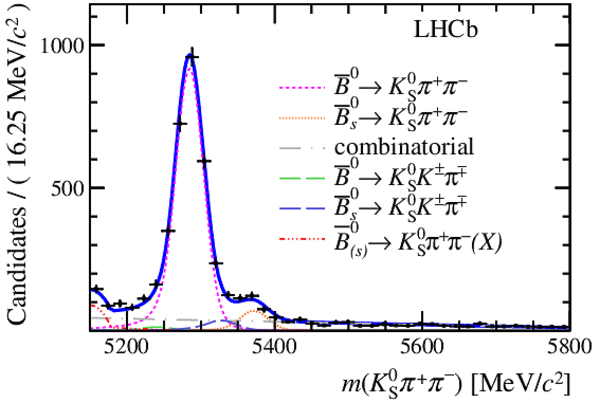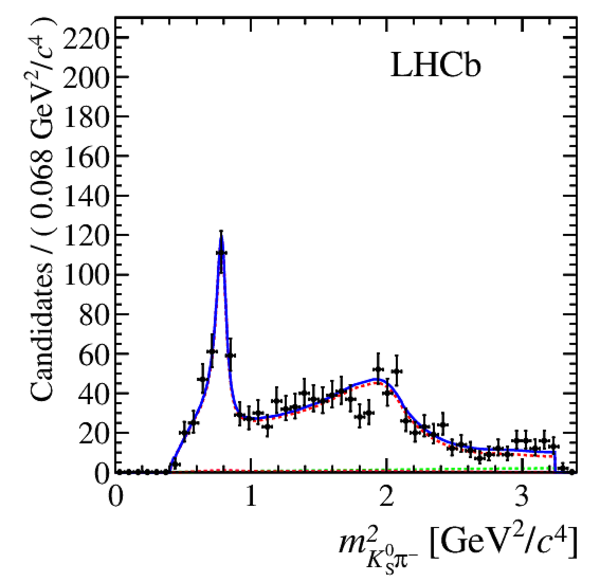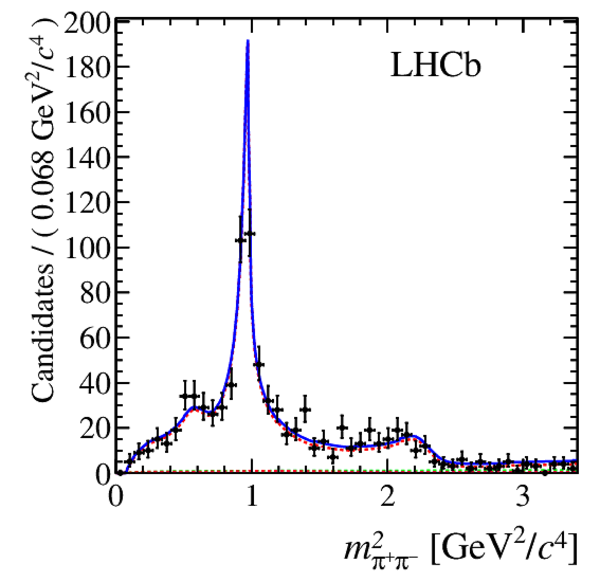Amplitude analysis of the decay $\overline{B}^0 \to K_{S}^0 \pi^+ \pi^-$ and first observation of the CP asymmetry in $\overline{B}^0 \to K^{*}(892)^- \pi^+$
[to restricted-access page]Information
LHCb-PAPER-2017-033
CERN-EP-2017-317
arXiv:1712.09320 [PDF]
(Submitted on 26 Dec 2017)
Phys. Rev. Lett. 120 261801
Inspire 1644906
Tools
Abstract
The time-integrated Dalitz plot of the three-body hadronic charmless decay ${{\overline{B}}^0 \to K_{\mathrm{\scriptscriptstyle S}}^0 \pi^+ \pi^-}$ is studied using a $pp$ collision data sample recorded with the LHCb detector, corresponding to an integrated luminosity of $3.0\;\mathrm{fb}^{-1}$. The decay amplitude is described with an isobar model. Relative contributions of the isobar amplitudes to the ${\overline{B}^0 \to K_{\mathrm{\scriptscriptstyle S}}^0 \pi^+ \pi^-}$ decay branching fraction and CP asymmetries of the flavour-specific amplitudes are measured. The CP asymmetry between the conjugate ${\overline{B}^0 \to K^{*}(892)^{-}\pi^+}$ and ${\overline{B}^0 \to K^{*}(892)^{+}\pi^-}$ decay rates is determined to be $-0.308 \pm 0.062$.
Figures and captions
|
Invariant mass distributions of $ K ^0_{\mathrm{ \scriptscriptstyle S}} \pi ^+ \pi ^- $ candidates, summing the two years of data taking and the two $ K ^0_{\mathrm{ \scriptscriptstyle S}}$ reconstruction categories. The sum of the partially reconstructed contributions from $ B $ to open charm decays, charmless hadronic decays, $\overline{ B }{} {}^0 \rightarrow \eta ^{\prime} K ^0_{\mathrm{ \scriptscriptstyle S}} $ and charmless radiative decays are denoted $\overline{ B }{} ^0_{(s)} \rightarrow K ^0_{\mathrm{ \scriptscriptstyle S}} \pi ^+ \pi ^- (X)$. |
FusedC[..].pdf [15 KiB] HiDef png [248 KiB] Thumbnail [204 KiB] |

|
|
Projections of the sum of all data categories (black points) and the nominal fit function onto the DP variables (left) $m_{K_{\rm S}^0\pi^+}^2$, (right) $m_{K_{\rm S}^0\pi^-}^2$ and (bottom) $m_{\pi^+\pi^-}^2$, restricted to the two-body low invariant-mass regions. The full fit is shown by the solid blue line and the signal model by the dashed red line. The observed difference is due to the (green) combinatorial and (light red) cross-feed background contributions, barely visible in these projections. |
DalPro[..].pdf [20 KiB] HiDef png [267 KiB] Thumbnail [225 KiB] |

|
|
DalPro[..].pdf [20 KiB] HiDef png [252 KiB] Thumbnail [216 KiB] |

|
|
|
DalPro[..].pdf [20 KiB] HiDef png [257 KiB] Thumbnail [215 KiB] |

|
|
|
Animated gif made out of all figures. |
PAPER-2017-033.gif Thumbnail |

|
Tables and captions
|
Components of the DP model used in the fit. The individual amplitudes are referred to by the resonance they contain. The parameter values are given in $ {\mathrm{ Me V /}c^2}$ for the masses and $\mathrm{ Me V}$ for the widths, except for $f_0(980)$ resonance. The parameter $m_0$ is the pole mass of the resonance and $\Gamma_0$ its natural width. The mass-dependent lineshapes employed to model the resonances are indicated in the third column. Relativistic Breit-Wigner and Gounaris-Sakurai lineshapes are denoted RBW and GS, respectively. EFKLLM is a parameterisation of the $ K ^0_{\mathrm{ \scriptscriptstyle S}} \pi^{-}$ S-wave lineshape, $(K\pi)^{-}_0$. |
Table_1.pdf [72 KiB] HiDef png [115 KiB] Thumbnail [55 KiB] tex code |

|
Created on 27 April 2024.
